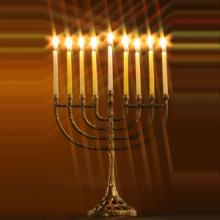The rituals of Hanukkah are fairly sparse in comparison to those of other holidays. Most of the observance is limited to at-home customs and there is very little in the way of a religious service. Some synagogues perform their own, semi-formal service, though there is no standard congregational service in the liturgy for the holiday. Hanukkah is meant to be kept in the home, though the lack of a traditional service also indicates that Hanukkah as a holiday came into being much later than more formalized observances like Yom Kippur and Passover. It's a holiday for people in the diaspora and people on the move. This, unfortunately, separates the average Jewish family from the guidance of those educated in the rituals, language and history of the faith. So, while it's easy for modern Jews to learn the Hanukkah prayers and even find their literal translations, it's less likely that they'll have access to the deeper meanings of those things.
Consider the most standard elements of Hanukkah at home. Every night, Jews on Hanukkah light the Khanukiah, a special, nine-branched Menorah candle holder. Many only know to add one candle for each successive night, though they don't know the proper order nor why we arrange the candles the way we do. The halakha, the standardized custom, of the Hanukkah candles is discussed in the Talmud by the scholars Hillel and Shammai. They debated how to properly arrange the candles, ultimately conceding to Hillel's position. He stated that the number of candles should increase as the holiday progresses in order to symbolize an increase in joy over time. It was also decided that the candles should begin at the far right branch and extend each night to the right until the Khanukiah is filled, representing the usual right-to-left method of reading Hebrew, with the newest candle being lit first.
The Hanukkah prayers themselves can be somewhat misleading without a scholarly eye. Though the first prayer is simply a Hanukkah-specific variation on the standard candle-lighting prayer one says on Shabbat, the second prayer (if a family even remembers to say it) is somewhat deeper in its intent. Simply referred to as "The Blessing for Hanukkah", it is actually a recognition of miracles from the past. The meaning of this prayer has become muddied over time, especially since the legend of the long-burning oil has replaced what the ancients would have recognized as the true miracle of Hanukkah.
The miracle was not the small amount of oil burning for eight days instead of one, itself just a parable told to symbolize the necessity for hope in troubled times. The miracle is that the Jews under Syrian Greek rule somehow threw off the oppression of their much stronger occupiers. Hanukkah is a celebration of hard-won freedom, not magic. By saying the prayer in recognition of miracles, we remind ourselves that extraordinary things have happened in the world, and more importantly that extraordinary things can happen in the world. It is not just a prayer that frames the past as a time when the seemingly impossible occurred, it is a reminder that the world is built on victory coming out of hopelessness. Hanukkah is relevant not just to the Jews of 1st century C.E. Israel, it is relevant to the Jews of Europe in the 1930's and 40's, to the Jews of modern Israel and to every individual who ever overcame great adversity. Just as Jews recognize that the covenant between God and Abraham is still valid to people alive today, we recognize that the capacity for miracles, in whatever form, is still possible for modern people.
It's important to understand that no Jewish observance, however old or esoteric, is entirely focused on the past. Even something as archaic as the lighting of Hanukkah candles is a deeply meaningful ritual.
